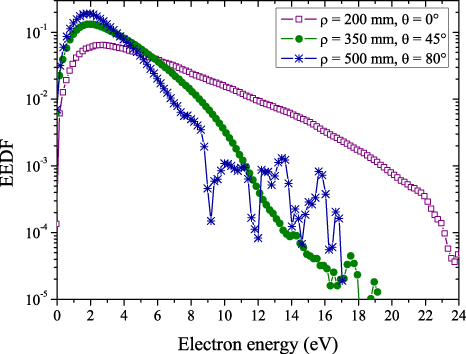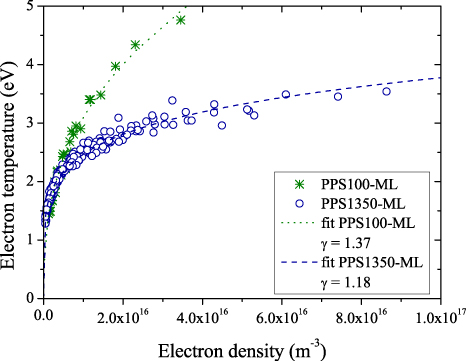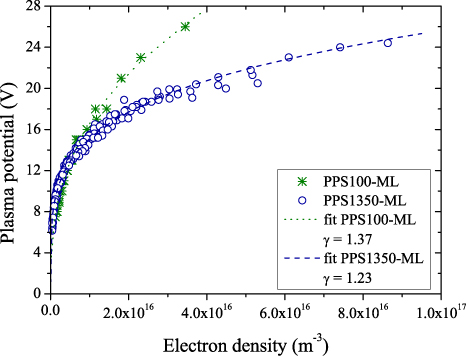Abstract
The plasma properties were investigated in the far-field plume of a 1.5 kW class Hall thruster using a single, cylindrical Langmuir probe. The plasma potential, the electron temperature and the electron density were measured at 191 positions, providing a detailed map of the plume pattern. This map shows that the plasma plume of a Hall thruster is an expanding jet that is symmetric about the thruster axis. The large data set was also used for a detailed analysis of the electron flow properties. This analysis reveals that the plasma plume of a Hall thruster is an isentropic expansion. In addition, the momentum conservation equation shows there is a polytropic relationship between the plasma potential and the electron density with a γ smaller than that for an atomic gas due to ionization.
Export citation and abstract BibTeX RIS
1. Introdution
A Hall thruster is a cross-field plasma device that is used for space propulsion [1]. The basic physics of a Hall thruster consists of a magnetic barrier in a low pressure dc discharge maintained between an external cathode and an anode [2–4]. The anode, which also serves as the gas injector, is located at the upstream end of a coaxial annular dielectric channel that confines the discharge. Xenon is generally used as the working gas for its specific properties in terms of atomic mass and low ionization energy. A set of solenoids or permanent magnets provides a radially directed magnetic field of which the strength is maximum in the vicinity of the channel exit. The magnetic field is chosen strong enough to make the electron Larmor radius much smaller than the discharge chamber sizes, but weak enough not to affect ion trajectories. The electric potential drop is mostly concentrated in the final section of the channel owing to the high electron resistivity. The corresponding local axial electric field drives a high azimuthal drift—the Hall current—that is responsible for the efficient ionization of the supplied gas. The electric field also accelerates ions out of the channel, which generates thrust. The ion beam is neutralized by a fraction of electrons emitted from the cathode.
The plasma plume of Hall thrusters exhibits a divergence angle of about 45 ° [5]. Although the plume is quasineutral, it still consists of charged particles, which leads to electrical and mechanical interactions with the spacecraft [6]. It is thus important to develop and improve models of the plume in order to help assessing the spacecraft integration issues. The numerical models of the thruster plume need to be validated by comparison with experimental data. Therefore the plasma plume needs to be mapped to obtain ion, electron and neutral properties.
So far, most of the experimental investigation has been focused on ion properties in the plasma plume of a Hall thruster. Although the electrons control the discharge and the plume dynamics, almost no experimental data on the electron flow properties can be found in the open literature. For numerical plume models the electron temperature is mostly assumed to be constant for the Boltzmann law. Hence, there is a clear need for experimental data concerning electron properties in the far-field plume of a Hall thruster. In this work, the plasma potential, the electron temperature and the electron density were measured by means of a single, cylindrical Langmuir probe at 191 positions in the far-field plume of the PPS®1350-ML. The large data set was then used to analyze the electron flow properties, showing that the plume of a Hall thruster is an isentropic expansion and that the electron properties can be linked by relations obtained from the momentum conservation equation.
2. Experimental setup
The electron properties were measured in the far-field plume of the 1.5 kW class PPS®1350-ML developed by Snecma. The PPS®1350-ML is the laboratory model of PPS®1350 used onbard the ESA SMART-1 space probe. The thruster was operated in a vacuum test bench 2.2 m in diameter and 4 m long at a background pressure of about 2 × 10−5 mbar. The thruster was mounted on a moveable arm, which allows a displacement along the thrust axis (the x-direction). The diagnostics were mounted on a second arm that moves perpendicular to the thrust axis (the y-direction). A rotation stage at the end of the diagnostics arm allows a displacement of the probes in the θ-direction, so that the probes always point toward the thruster center. The combination of the displacements of the probes in the y- and θ-direction together with the possibility to move the thruster along its axis allows mapping the complete far-field plume in polar coordinates. A single cylindrical Langmuir probe was used to characterize the far-field plume of the PPS®1350-ML. The Langmuir probe was made of a tungsten wire 0.38 mm in diameter. The non-collecting part of the wire was insulated from the plasma by an alumina tube 100 mm long and 2 mm in diameter. The length of the collecting part was 5 mm. The voltage sweep and the resulting probe current measurement were performed using the ALP System™ manufactured by Impedans. The parameters Vp, Te and ne were derived from the probe characteristics using the standard Langmuir probe theory in a collisionless and magnetic field-free plasma assuming a Maxwellian electron distribution function [7, 8]. The plasma potential is obtained from the maximum of the first derivative of the probe characteristic (Vp = (dI/dV)max). The electron temperature is determined from the slope of the logarithm of the electron current in the transition region (Te = (d ln Ie/dV)−1). The electron density is calculated using the orbit motion limited (OML) assumption: in the OML regime the slope of
 versus V plot is proportional to
versus V plot is proportional to
 . For the analysis of the measured I–V characteristics the Start program developed by P Kudrna at the Charles University in Prague was used. Prior to the analysis it had to be checked if the electron energy distribution function (EEDF) was Maxwellian. An example of three different EEDFs measured in the far-field plume of the PPS®1350-ML is shown in figure 1. As can be seen, the EEDF can be assumed to be Maxwellian except for the high-energy tail.
. For the analysis of the measured I–V characteristics the Start program developed by P Kudrna at the Charles University in Prague was used. Prior to the analysis it had to be checked if the electron energy distribution function (EEDF) was Maxwellian. An example of three different EEDFs measured in the far-field plume of the PPS®1350-ML is shown in figure 1. As can be seen, the EEDF can be assumed to be Maxwellian except for the high-energy tail.
Figure 1. Example of three EEDFs measured at different positions in the far-field plume of the PPS®1350-ML operating at 350 V and 4.8 mg s−1.
Download figure:
Standard image High-resolution image3. Results
The PPS®1350-ML was operated at a discharge voltage of 350 V, an anode mass flow rate of 4.8 mg s−1, a cathode mass flow rate of 0.45 mg s−1 and a coil current of 4.5 A. The mean discharge current was 4.3 A and the cathode-to-ground potential −20.8 V.
The electron properties (Vp, Te and ne) were measured with a single cylindrical Langmuir probe at 191 positions in the far-field plume of the PPS®1350-ML: from −10 ° to 45 ° measurements were taken every 5 ° and from 200 to 500 mm every 25 mm (156 measurement positions in total); from 50 ° to 90 ° measurements were taken every 10 ° and from 200 to 500 mm every 50 mm. Note that 0 ° corresponds to the thruster axis and 0 mm to the thruster exit plane.
3.1. Complete far-field map of the electron properties
The complete map in the far-field plume of Vp, Te and ne measured between 200 and 500 mm and from −10° to 90° with the Langmuir probe is shown in figure 2. The profiles are interpolated from the 191 different measurement positions. As can be seen in figure 2, Vp, Te and ne decrease with an increasing distance from the thruster exit plane and from the thruster axis. This can be explained by the fact that the plume of a Hall thruster is an expanding plasma jet. Furthermore, one can clearly see that the plasma plume is symmetric about the thruster axis.
Figure 2. Complete map of the plasma parameters (Vp, Te and ne) in the far-field plume of the PPS®1350-ML operating at 350 V and 4.8 mg s−1.
Download figure:
Standard image High-resolution imageIn order to validate the Langmuir probe measurements, the plasma potential is also measured by a heated emissive probe. The values obtained with the two different probes are in good agreement.
3.2. Electron flow properties
The data from the complete far-field map can be used for a more detailed analysis of the electron flow properties in the far-field plume of a Hall thruster.
The expansion of a plasma into a vacuum can often be considered as a steady expansion. The flow which is initially in thermodynamic equilibrium can be assumed to be adiabatic and if the flow is laminar, the expansion is isentropic. For a steady isentropic flow, the energy conservation equation can be replaced by the Poisson adiabatic relation when the electron gas follows the perfect gas law:

where γ is the specific heat ratio or isentropic exponent and Te,0 a reference electron temperature [9]. Figure 3 represents the electron temperature as a function of the electron density for the 191 different measurement positions in the far-field plume of the PPS®1350-ML thruster operating at 350 V and 4.8 mg s−1. Another data set is also represented. This data set was obtained during a previous measurement campaign in the far-field plume of the PPS®100-ML operated at 300 V and 4.0 mg s−1 [10]. The isentropic fit (equation (1)) for the two thrusters is also represented (dashed line). As can be seen, the plasma plume of a Hall thruster is an isentropic expansion. The isentropic exponent γ is different for the two thrusters, namely 1.18 for the PPS®1350-ML and 1.37 for the PPS®100-ML. The theoretical isentropic exponent for xenon is γ = 5/3 (atomic gas). However, in a plasma the value of γ is lower than the theoretical value for the gas as an additional degree of freedom is caused by ionization [11, 12]. Knoll and coworkers have already shown that the electron transport in Hall thrusters can be described by a simple isentropic model [13]. However, they use the theoretical value of γ for their model.
Figure 3. Electron temperature as a function of the electron density in the far-field plume of the PPS®1350-ML operating at 350 V and 4.8 mg and the PPS®100-ML operating at 300 V and 4.0 mg s−1. The isentropic fit is also shown for the two thrusters (dashed/dotted line).
Download figure:
Standard image High-resolution imageThe electron flow properties can also be analyzed with respect to the momentum conservation equation. Assuming that the electron flow is in steady state (D/Dt = 0) and that there is no magnetic field, the stationary electron momentum conservation equations can be written as the balance between the electron pressure and the electric field [14]:

The electric field E can be represented as the gradient of the plasma potential (E = −∇Vp). For a constant electron temperature, equation (2) leads to the well-known Boltzmann law which relates the stationary electron density to the plasma potential:

where n0 is the average electron density and Te is in eV [14]. As can be seen in figure 2, the electron temperature in not constant and equation (3) is thus not valid. For the non-isothermal case, equation (2) leads to the following relationships between the electron density and the plasma potential and between the plasma potential and the electron temperature when equation (1) is used to describe the electron fluid:


where γ is the isentropic exponent. Figure 4 shows the plasma potential as a function of the electron density for the 191 measurement positions in the far-field plume of the PPS®1350-ML as well as for the 35 measurement positions in the far-field plume of the PPS®100-ML. As can be seen, the stationary electron momentum conservation equation is valid in the plasma plume of a Hall thruster assuming a non-isothermal medium. The value of γ obtained from equation (5) is 1.23 for the PPS®1350-ML and 1.37 for the PPS®100-ML. These values are in good agreement with that obtained from equation (1). Figure 5 shows the electron temperature as a function of the plasma potential for the 191 measurement positions in the far-field plume of the PPS®1350-ML as well as for the 35 measurement positions in the far-field plume of the PPS®100-ML. As can be seen, Te is proportional to Vp for the two thrusters, as expected from the momentum conservation equation.
Figure 4. Plasma potential as a function of the electron density in the far-field plume of the PPS®1350-ML operating at 350 V and 4.8 mg. and the PPS®100-ML operating at 300 V and 4.0 mg s−1. The corresponding fits are also shown (dashed/dotted line).
Download figure:
Standard image High-resolution imageFigure 5. Electron temperature as a function of the plasma potential in the far-field plume of the PPS®1350-ML operating at 350 V and 4.8 mg and the PPS®100-ML operating at 300 V and 4.0 mg s−1.
Download figure:
Standard image High-resolution image4. Conclusion
This work presents detailed measurements of the electron properties in the far-field plume of the PPS®1350-ML Hall thruster. A complete map of Vp, Te and ne is measured from 200 to 500 mm downstream of the thruster exit plane and from −10° to 90°, where 0° corresponds to the thruster axis. It is shown that the the plasma plume of a Hall thruster is an isentropic expansion, i.e. adiabatic and reversible, that is symmetric about the thruster axis. Furthermore, it is demonstrated that the steady electron momentum conservation equation can be used to obtain different relations between Vp, Te and ne. The values of the isentropic exponent γ obtained from the Poisson adiabatic law and from the momentum conservation equation are in good agreement. Previous measurements with a different 1.5 kW-class Hall thruster (PPS®100-ML) show similar results, but the values of γ are different for the two thrusters. A more detailed study of the influence of the operating conditions, the thruster size and the working gas would certainly be of great interest for the improvement of the accuracy of existing numerical plume models.
Acknowledgments
This work was carried out in the frame of the CNRS/CNES/SNECMA/Universités joint research program GdR 3161 entitled 'Propulsion par plasma dans l'espace'. The authors would like to thank P Kudrna and M Tichý for their advice with the data analysis. E Ahedo is also acknowledged for stimulating discussions.





